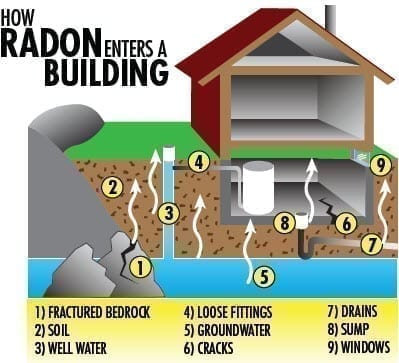Radon Inspections
 What is Radon?
What is Radon?
Radon is a silent gas that is colorless and odorless. It is a naturally-occurring radioactive gas that can be found in homes in all 50 states, and it’s estimated that 21,000 lung cancer deaths per year are caused by radon.
As part of your home inspection, Brick House Inspections can inspect your home to help determine the number of picocuries per liter a home may have. If the radon levels in your home exceed 4 picocuries per liter, you should take steps to reduce the radon level as soon as possible. Keep in mind that radon mitigation WILL fix this problem.
We are certified to conduct tests for:
- Single-family residential
- Multi-family residential
- Mixed Use commercial/residential
- Large Buildings and schools
Brick House Inspections is Downriver’s only home inspector that is a qualified radon inspector, and we will provide a thorough report from our state-of-the-art testing equipment.
Common Radon Questions
Any home may have a radon problem.
Radon is a radioactive gas. It comes from the natural decay of uranium that is found in nearly all soils. It typically moves up through the ground to the air above and into your home through cracks and other holes in the foundation. Your home traps radon inside, where it can build up. This means new and old homes, well-sealed and drafty homes, and homes with or without basements.
Radon from soil gas is the main cause of radon problems. Sometimes radon enters the home through well water. In a small number of homes, the building materials can give off radon, too. However, building materials rarely cause radon problems by themselves.
(Copied from www.epa.gov)
Elevated radon levels have been found in every state. Radon gas given off by soil or rock can enter buildings through cracks in floors or walls; construction joints; or gaps in foundations around pipes, wires, or pumps. Radon levels are usually highest in the basement or crawl space.
(Copied from cancer.org)
There are no immediate symptoms from exposures to radon. Based on an updated Assessment of Risk for Radon in Homes, radon in indoor air is estimated to cause about 21,000 lung cancer deaths each year in the United States. Smokers are at higher risk of developing Radon-induced lung cancer. Lung cancer is the only health effect which has been definitively linked with radon exposure. Lung cancer would usually occur years (5-25) after exposure. There is no evidence that other respiratory diseases, such as asthma, are caused by radon exposure and there is no evidence that children are at any greater risk of radon induced lung cancer than adults.
(Copied from www.epa.gov)
EPA has maintained the position that radon measurement systems provide practical and affordable measurements that can give consumers the information they need about the radon level in their home in order to make a decision about whether to fix their home.
Results presented in [a contractor report that reviews current radon measurement proficiency data and compares it to earlier data] support EPA’s position that radon testing devices provide accurate and reliable results and that EPA’s measurement recommendations raise the probability that high homes will be identified and fixed. While any measurement system has an associated variability in precision and accuracy, we expect that radon test devices that are used properly will provide accurate and reliable results.
(Copied from www.epa.gov)
You have tested your home for radon, but now what? If you have tested your home for radon and confirmed that you have elevated radon levels, 4 picocuries per liter in air (pCi/L) or higher, our guidance can help you:
- Select a qualified radon mitigation contractor to reduce the radon levels in your home.
- Determine an appropriate radon reduction method.
- Maintain your radon reduction system.
Radon reduction systems work. Some radon reduction systems can reduce radon levels in your home by up to 99 percent. Most homes can be fixed for about the same cost as other common home repairs. Your costs may vary depending on the size and design of your home and which radon reduction methods are needed. Get an estimate from one or more qualified radon mitigation contractors. Hundreds of thousands of people have reduced radon levels in their homes.
(Copied from www.epa.gov)
Radon has a nickname that could easily scare away any potential home buyer: “The Silent Killer.” But there’s no need for radon to be a deal-breaker in any real estate transaction. Thanks to proven mitigation techniques, high radon concentrations in a home’s interior can be reliably and permanently reduced to acceptable levels.
A radon test should be part of any building inspection
The building inspection that takes place when a home is sold should include a radon test – even if the house has an existing radon mitigation system. As long as proper house conditions are maintained during the “detection” phase of a radon test, results will be accurate. If the house shows a concentration level above 4 picocuries per liter, the EPA recommends that radon levels be reduced with a mitigation system.
(Copied from homes.com)
No, we do not BUT Brick House Radon Solutions does. We are licensed to only test for the presence of radon. If your home tests for an excessive amount of radon, we cannot mitigate your home for one year due to a conflict in interest.
Having said that, if you have had a test by another source, you can contact us at Brick House Radon Solutions to mitigate the radon.
The answer depends on the type of test. If a CRM is used the results are the same day, and the testing period is 72 hours. If LS (Liquid Scinillation) is used, the test equipment must be mailed to the lab with a 3-5 day turnaround for results. It is typically used in large commercial buildings or multifamily dwellings that are not being tested for real estate purposes.
During the test, the house must have closed-house conditions for 12 hours before the test and the time. Closed house conditions are, no windows or doors left open other than for normal use. No attic fans are to be used 12 before and during testing. Indoor forced air HVAC should be run to maintain a temperature between 65-82 F with the thermostat set on Auto so the fan isn’t constantly running. No testing can be conducted during severe weather.

